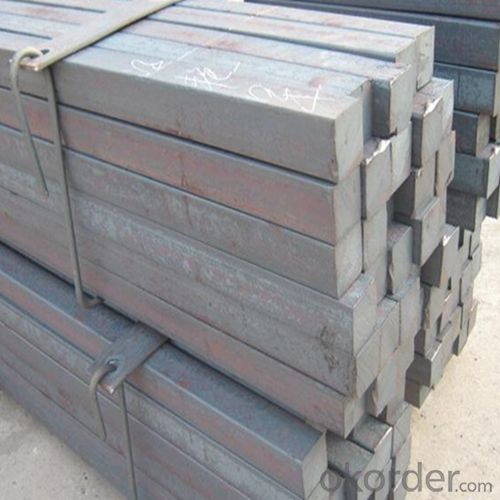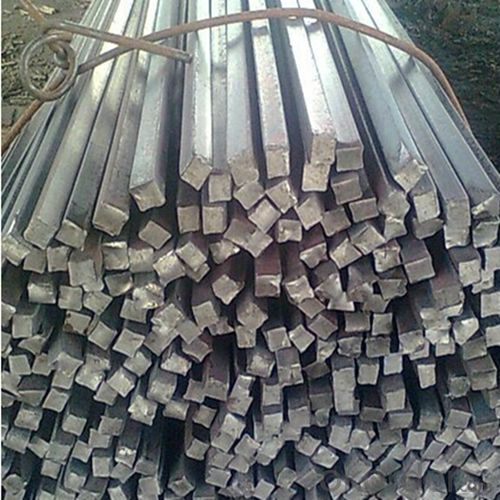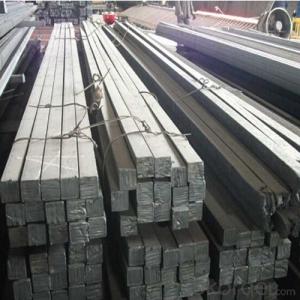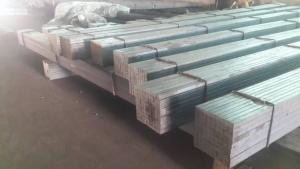Steel Square Bar Small Sizes with Length of 6 Meters
- Loading Port:
- Tianjin
- Payment Terms:
- TT or LC
- Min Order Qty:
- 25 m.t.
- Supply Capability:
- 10000 m.t./month
OKorder Service Pledge
OKorder Financial Service
You Might Also Like
1. Structure of Steel Square Bar Small Sizes description:
Steel square bar small sizes is a bar with square shaped cross-section. It is special case of equal sides. Before steel products are sold on the market, the steel must first be processed into more functional pieces. Raw steel cannot be of use while in its pure form, thus it has to be cast into shape. The freshly made steel, Steel square bar small sizes is still in the form of a metal bar or rectangle. Small sizes of Steel square bar small sizes are used in ship building.
2. Main Features of Steel Square Bar Small Sizes:
• Grade: Q235
• Type: Mild carbon steel
• A quadrilateral with four equal sides and four right angles.
• Vibration: The stiffness and mass are chosen to prevent unacceptable vibrations, particularly in settings sensitive to vibrations, such as offices and libraries.
• Local yield: Caused by concentrated loads, such as at the beam's point of support.
3. Steel Square Bar Small Sizes Images:


4. Steel Square Bar Small Sizes Specification:
Mechanical Properties | Grade | Steel diameter(mm) | |||
≤16 | 16~40 | 40~60 | 60~100 | ||
Yield Point Δs/MPa | Q195 | ≥195 | ≥185 | - | - |
Q235 | 235 | 225 | 215 | 205 | |
Tensile Strength | Q195 | 315~390 | |||
Q235 | 375~500 | ||||
Elongation δ5% | Q195 | ≥33 | ≥32 | - | - |
Q235 | 26 | 25 | 24 | 23 | |
5. FAQ
We have organized several common questions for our clients,may help you sincerely:
①What is the main material?
There are two types of Square Bar, one is hot rolled square bar and other one is cold drawn square bar. Our principal products is hot rolled square bar. We dedicate to products with material Q195 and Q235. We offer products with high quality and low price.
②How to inspect the quality?
We have a professional inspection group which belongs to our company. We resolutely put an end to unqualified products flowing into the market. At the same time, we will provide necessary follow-up service assurance.
③Is there any advantage about this kind of product?
Steel I beam bar IPE has a reduced capacity in the transverse direction, and is also inefficient in carrying torsion, for which hollow structural sections are often preferred.
- Q:How does a steel square assist in determining the correct angle for a half-blind dovetail joint?
- A steel square can be a helpful tool in determining the correct angle for a half-blind dovetail joint. This type of joint is commonly used in woodworking to create a strong and aesthetically pleasing connection between two pieces of wood, typically seen in drawers or boxes. To create a half-blind dovetail joint, one side of the joint is visible while the other side is concealed within the wood. The visible side is usually cut at a 90-degree angle to create a neat and clean appearance. The concealed side, however, needs to be cut at an angle that matches the slope of the dovetail pins. This ensures a snug fit and a strong joint. Here's where a steel square comes in handy. A steel square is a flat, triangular-shaped tool with a 90-degree angle. By using the steel square, you can accurately determine the angle needed to cut the concealed side of the joint. First, mark the desired angle on the steel square. This angle should match the slope of the dovetail pins, typically 7 to 9 degrees. Then, place the steel square against the edge of the wood piece, aligning the marked angle with the edge. By holding the square firmly in place, you can now use it as a guide to cut the concealed side of the joint at the correct angle. By using a steel square, you can ensure that the angle of the half-blind dovetail joint is accurate and matches the slope of the dovetail pins. This precision helps in achieving a tight and professional-looking joint, enhancing both the strength and visual appeal of the finished woodworking project.
- Q:Can a steel square be used for creating dado joints?
- Indeed, dado joints can be created using a steel square. A steel square proves to be a flexible and precise instrument that serves various woodworking purposes, among them the creation of dado joints. By employing the square, one can accurately delineate the appropriate width and depth of the dado joint, guaranteeing meticulous and precise cuts. Moreover, the square can be utilized to align the saw blade or router bit, ensuring the proper placement of the dado joint. All in all, a steel square proves to be an invaluable tool in the creation of dado joints, allowing for professional and meticulous outcomes to be achieved.
- Q:Can a steel square be used for plumbing tasks?
- Indeed, plumbing tasks can indeed make use of a steel square. Although its primary purpose lies in carpentry, where it serves to measure and designate right angles, a steel square can also prove advantageous in plumbing tasks. One noteworthy application is its ability to guarantee the correct alignment and perpendicularity of pipes to walls or floors. Furthermore, it can aid in measuring and marking cuts on pipes and other plumbing materials. Nevertheless, it is crucial to acknowledge that plumbing-specific tools, like pipe wrenches and pipe cutters, might be more appropriate and efficient for certain plumbing jobs.
- Q:How do you use a steel square to measure and mark parallel lines?
- To measure and mark parallel lines using a steel square, adhere to the following steps: 1. Position the steel square onto the material's edge where the lines will be marked. Verify that the long side of the square aligns with the edge of the material. 2. Securely hold the square in place, making certain that it remains immobile and does not shift throughout the process. 3. Take a pencil or marking tool and glide it along the square's shorter side, creating a line on the material that runs parallel to the edge. 4. Repeat this process at various points along the edge, marking multiple parallel lines as necessary. By consistently aligning the steel square with the edge and gliding the marking tool along its shorter side, you can guarantee that the lines you mark will be parallel to the material's edge. This technique proves beneficial in various trades, including carpentry, woodworking, metalworking, and other disciplines that demand precise and parallel lines.
- Q:How do you use a steel square to measure and mark 151.875-degree angles?
- To use a steel square to measure and mark a 151.875-degree angle, you need to follow the steps below: 1. Place the steel square on a flat surface or the material you want to mark the angle on. 2. Align the long side of the square (known as the blade) with one of the edges of the material. 3. Rotate the square until the 90-degree corner is aligned with the edge of the material. This ensures that the square is perpendicular to the edge. 4. Once the square is aligned, locate the 45-degree angle mark on the blade. This mark is usually denoted by a diagonal line. 5. Start counting the degree marks from the 45-degree mark, moving towards the edge of the square. Each degree mark is generally labeled, making it easier to identify the desired angle. 6. Continue counting until you reach the 30-degree mark. This mark is usually located on the opposite side of the 45-degree mark. 7. Once you have identified the 30-degree mark, keep counting in the same direction until you reach the 1.875-degree mark. This mark is usually located closer to the edge of the square. 8. Finally, make a small mark or draw a line at the 1.875-degree mark to indicate the desired angle. By following these steps, you can effectively use a steel square to measure and mark a 151.875-degree angle.
- Q:Can a steel square be used for checking the squareness of a foundation?
- Checking the squareness of a foundation can be accomplished with the use of a steel square. In the field of carpentry and construction, a steel square is a versatile tool that is frequently employed for the purpose of verifying and marking right angles. Comprised of two arms connected at a 90-degree angle, one of these arms being longer than the other, the steel square is an effective instrument. When the longer arm is placed against a straight edge of the foundation and the shorter arm is aligned with another edge, it becomes possible to determine whether the foundation is square or not. If the angles formed measure 90 degrees, then the foundation is indeed square. However, it is crucial to acknowledge that when dealing with larger foundations or when a higher degree of precision is required, more accurate tools such as laser levels or transit levels may be employed in conjunction with the steel square.
- Q:What are some common misconceptions about using a steel square?
- Addressing the misconceptions surrounding the use of a steel square is important as there are several that deserve clarification. Firstly, it is commonly believed that a steel square is solely intended for right angles. While it is indeed ideal for measuring and marking right angles, it can also be utilized for a wide range of other tasks. For instance, determining the pitch or slope of a roof, laying out stair stringers, and creating parallel lines are all possible with a steel square. Secondly, there is a misconception that using a steel square is challenging. Although it may appear daunting initially, with some practice, utilizing a steel square becomes second nature. Beginners can easily grasp the fundamentals of using a steel square through the abundance of resources available, including tutorials and videos. By dedicating time and effort to practicing, anyone can become proficient in employing this versatile tool. Furthermore, there exists a belief that a steel square is outdated, having been replaced by digital measuring devices. While it is true that technology has introduced a wide array of measuring tools, the steel square remains a reliable and accurate option. Its simplicity and durability make it a staple in various professional trades, such as carpentry and masonry. Additionally, it does not necessitate batteries or calibration, rendering it both cost-effective and dependable. Lastly, some individuals assume that a steel square is exclusively useful for professional builders or craftsmen. However, this is not the case. Whether you are a DIY enthusiast or a professional, incorporating a steel square into your toolbox can prove highly valuable. Its versatility and user-friendly nature make it an excellent tool for a diverse range of projects, ranging from simple woodworking to complex construction tasks. In conclusion, the misconceptions surrounding the use of a steel square need to be addressed. It is not limited to right angles, it is not difficult to use, it is not outdated, and it is not exclusively for professionals. By understanding and dispelling these misconceptions, individuals can truly appreciate the usefulness and versatility of this timeless tool.
- Q:Can a steel square be used for checking the alignment of drill press tables?
- Yes, a steel square can be used for checking the alignment of drill press tables. A steel square is a versatile tool that can be used for measuring and checking right angles. By placing the steel square against the drill press table and the drill bit, you can ensure that the table is perpendicular to the drill bit and thus aligned properly. This is important for drilling accurate and precise holes. Additionally, the steel square can also be used to check the squareness of the table itself, ensuring that it is not tilted or misaligned. Overall, a steel square is a handy tool for verifying the alignment of drill press tables.
- Q:What are the common accessories that come with a steel square?
- Included with a steel square are typically common accessories like a scribe tool, a layout tool, and a protractor. The scribe tool, often fashioned as either a sharp point or a small blade, is utilized to make markings and measurements on surfaces. It is an indispensable accessory for precise and accurate marking. A layout tool, such as a try square or a miter square, is employed to ensure perpendicular and precise angles when marking or cutting materials. These tools aid in aligning edges and corners to create exact right angles. A protractor, commonly present on larger steel squares, is used to measure and mark angles that are not 90 degrees. It proves particularly beneficial when undertaking tasks that require bevel cuts or when shaping irregular forms. Additional potential accessories that may accompany a steel square include a level vial, which assists in determining surface levelness, and a center finder, which facilitates locating the center of circular or cylindrical objects. The specific accessories accompanying a steel square may differ depending on the brand and model, but the aforementioned are some of the commonly encountered ones.
- Q:It can be used as the steel electrical equipment grounding
- In the electrical grounding body, generally use the steel pipe, angle steel, flat steel, round steel and other steel specially made grounding. The artificial grounding body and the ground wire form a grounding device, so that various earthing of the electrical equipment is connected with the ground through a grounding device. The artificial earthing body has two kinds of vertical embedment and horizontal embedment. The vertical buried pipe, angle steel, round steel grounding body, and have sufficient mechanical strength; ground level buried body with round steel, flat steel, common type, with several ring and radiation type. It is better to use galvanized steel when laying artificial earth in strongly corrosive soil. The steel used in the earth body shall be in accordance with the requirements of thermal stability and uniform pressure.
1. Manufacturer Overview |
|
|---|---|
| Location | |
| Year Established | |
| Annual Output Value | |
| Main Markets | |
| Company Certifications | |
2. Manufacturer Certificates |
|
|---|---|
| a) Certification Name | |
| Range | |
| Reference | |
| Validity Period | |
3. Manufacturer Capability |
|
|---|---|
| a)Trade Capacity | |
| Nearest Port | |
| Export Percentage | |
| No.of Employees in Trade Department | |
| Language Spoken: | |
| b)Factory Information | |
| Factory Size: | |
| No. of Production Lines | |
| Contract Manufacturing | |
| Product Price Range | |
Send your message to us
Steel Square Bar Small Sizes with Length of 6 Meters
- Loading Port:
- Tianjin
- Payment Terms:
- TT or LC
- Min Order Qty:
- 25 m.t.
- Supply Capability:
- 10000 m.t./month
OKorder Service Pledge
OKorder Financial Service
Similar products
New products
Hot products
Hot Searches
Related keywords



























